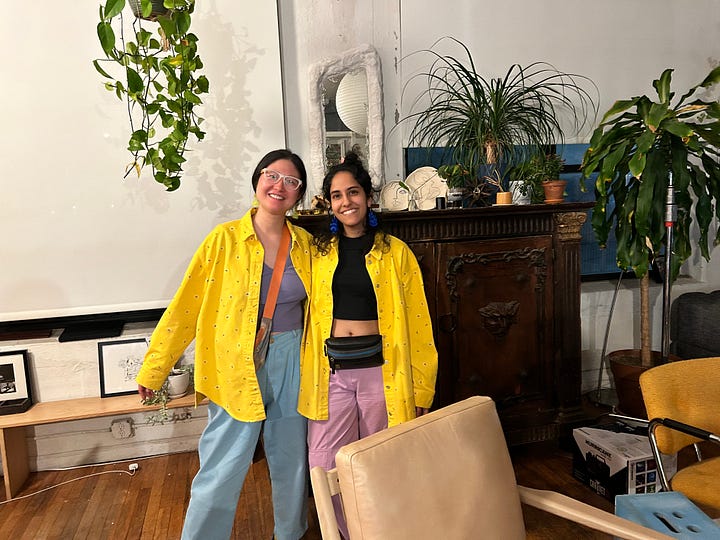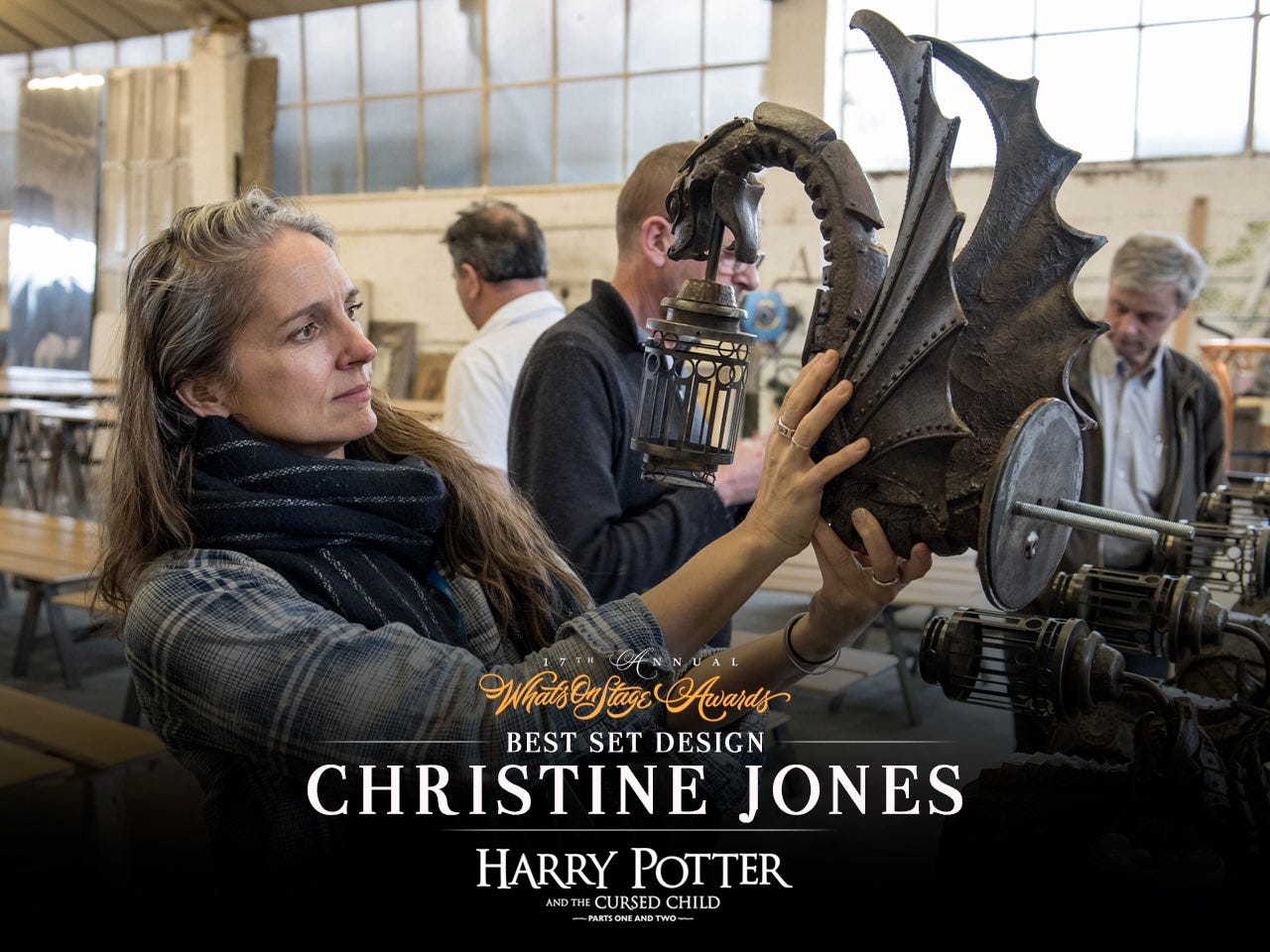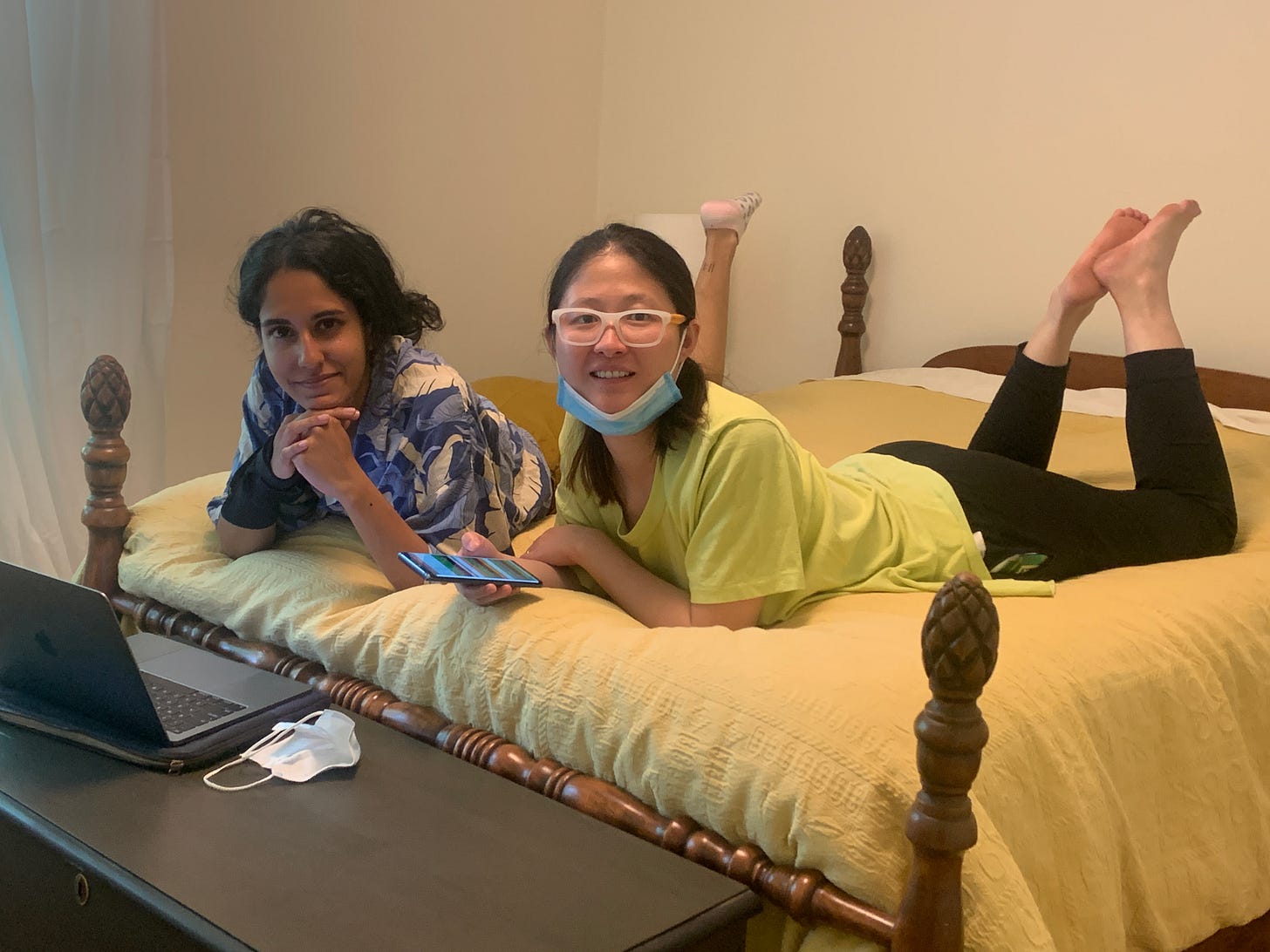Collab Volume One: Circles Rise!
Christine Jones, Rhea Da Souza and Aoshuang Zheng (plus Yvonne, Maryam, Mahira and me)
It’s November, and I want to talk about collaboration.
More to the point, I want to talk about the way in which circles of women inspire and support one another, and, ideally, support the rise of new circles.
As many of you know, I wrote the role of Ramona for my dear friend, actor Yvonne Woods, and I wrote the role of Mansbach hoping and praying that Rob Beitzel would play him. (He did).
Yvonne and Rob and I have been working together since we were students at Juilliard more than 20 years ago. Not long after Juilliard, we met designer Christine Jones. We were part of a circle. That circle of theater people was one of my favorites, a group I will cherish eternally. We lived together, worked together, saw each others plays (in production and in readings all over town). We helped each other prepare, held each other’s hands when things didn’t go our way and celebrated at the East Fourth Street bar when they did. We were on the rise together. But more than that, we were a family.
Christine Jones has always been magical. Back in the day the way she spoke, with eloquence and economy, about the rules of each play she designed inspired me to think differently about visual storytelling. Her work showed me how a designer can support the ultimate meaning of a play in ways I hadn’t seen before. Also, she had great taste in music.
Christine created The Theatre For One, an investigation into what happens between one audience member and one performer, should they meet face to face—and for its inaugural pilot on the East Fourth Street block outside New York Theater Workshop, Christine directed Yvonne in a one-person adaptation of my play Defusion. It was exciting to turn a two-hander into a monologue and terrifying when Yvonne got sick and I had to understudy.
Theatre For One (TF1) has since exploded, and Christine has proven herself to be one of the most gifted production designers around, recently winning big awards for her work on Harry Potter and the Cursed Child. (Her list of credits is like a Best of Theater of the last decade).
Christine is also a mother; when she gave birth to her first and brought him to my Nolita apartment, laying him on the bed while we had tea, I began to understand that I could be both mother and artist—the two identities didn’t have to be in conflict, as Ramona says about Patti Smith. Like Smith, Christine Jones never stopped being herself.
Collaborative models, circles, are generative, inclusive, and ideally remunerative. We help each other. Paula Vogel always said, “Circles rise.” (Not to me specifically, but I have it on good authority that she said it a lot.) Ramona At Midlife became a testament to that—to the rise and to actually flying together. So it was only natural that when I needed designers for Ramona, I’d reach out to her and ask about her former students and mentees.
Christine introduced me to Rhea Michelle d’Souza and Aoshuang Zheng, the design team behind Ramona. And we had a blast working together. At first they pitched “Ramona has a lot of plants.” I countered with “I don’t know…I kill plants. But what if her books are like plants?” And right then and there, both women nodded like they totally understood and came up with a new plan.
It was even more exciting to learn that Rhea collaborates with of my very talented and excellent former students, Maryam Mir. Rhea designed Maryam’s award-winning short Sweet Refuge which features fellow Juilliard alum Mahira Kakkar.
Mahira also has a featured role in Naomi McDougal Jones hilarious Bite Me! And Naomi introduced me to Kristen Vaganos, the lead producer on Ramona!
Do you see the magic here? All of these incredible women overlapping, working together, contributing to each other’s creative work and lives?


Here is our conversation about collaboration, mentors and inspiration:
BB: What’s important to you about collaboration? And how do you find your collaborators?
Christine: Sometimes collaborations find me, and then a relationship begins. Other times I follow my art crushes and reach out to new people. Sometimes I follow an instinct that a certain person is right for a certain project. Serendipity and then steadily getting to know each other, finding a shared language that develops over years.
Rhea: I believe in the organic nature of finding collaborators. They come from a variety of places, often serendipitously, when I least expect it. Over time I’ve realized the importance of community and mutual respect for the people I work with and admire. The collaborators I continue to work with are not just filmmakers and artists I admire; they are also the most wonderful people with whom I truly enjoy every step of the process. Which helps on the days when the jobs I love aren’t very lovable.
Aoshuang: I feel incredibly lucky to have found Rhea! We’ve always enjoyed each other's company, both in life and at work. I think we really bonded through the difficulties and challenges we faced together.
BB: Who were your mentors?
Rhea: I had a variety of mentors from when I was working in India, a group of unbelievable women who were some of the best production designers in the country. In an industry that is fairly male dominated, it was such an inspiration watching them navigate the world. In New York, one of my first mentors was Christine Jones. I was and always will be in complete awe of her as a designer and as a human being. Very often I think of her various teachings, and I feel an immense sense of honor to be able to know her in the capacity that I do. She taught me the power of emotion and empathy within the design process and the ability to express it in a way that adds depth to the design.
Aoshuang: One of my first mentors was Christine Jones. When I moved from China to New York 8 years ago to study at NYU, I struggled with English, but Christine was incredibly open and supportive. She helped me embrace my voice, showing me how to present myself with confidence despite language barriers. Her guidance shaped my approach, both personally and professionally.
I graduated during the peak of Covid, when the industry was shut down and was fortunate to receive incredible support from many teachers and designers. I’m deeply grateful to them. David Stein devoted countless hours to teaching me drafting and problem-solving. Molly Hughes guided me through the intricacies of navigating the film world.
Christine: In my college years I struggled to find mentors. The teachers in my department at Tisch were 95% older males. The first directors I worked with for years were males. Tony Walton took me under his wing and was a cheerleader for sure, but it wasn't until later in life that I found true mentorship in the form of teaching colleagues and other collaborators. Susan Hilferty, and Constance Hoffman, both costume designers, impacted me greatly. There were very few women who were also having children in our field when I started out, and if they were set designers I never met them because we wouldn't be on projects together. I was very lucky that I started working soon after school, but I missed out working as an associate and the valuable mentorship experiences that role can offer.
BB: How do you nurture and feed the next generation?
Rhea: As Asian immigrant women we (Aoshuang and I) both come from similar work environments in India and China, followed by the experience of navigating a foreign country alone and creating a community from scratch. We both feel immensely lucky to have each other as a support system not just professionally but also in our personal growth. We both believe very much in fostering a new generation of individuals not just to be great designers but also good collaborators. As adjunct faculty at NYU, a large part of what we try to impart is self care and safety and respect for fellow artists.
BB: Is there something in any of this that feels, to you, specific to ways in which generations of female-identified artists reach out to each other and/or have nurtured the next generation?
Rhea: As women, we are raised in different ways and made to navigate a different set of obstacles. It is our collective experiences and support that make us stronger and I have long given up on the possibility of navigating the world alone. I don’t think it’s impossible, it’s just not the way I want to go through my life and career. I find myself much more fulfilled by the idea that I have a solid support system that directly and indirectly connects me to a much larger community of women across the country and the rest of the world.
BB: What are you excited about?
Aoshuang: Rhea and I are working to create a design company and website together called “FUN FUN COLLECTIVE.”
Rhea: We sometimes sell earrings in Fort Greene Park. Our Instagram is Third Ear. Aoshuang and I are also getting more into the live event space and working on designing music events with DJ’s and live musicians. We are inspired by artists who manipulate space, light and sound to enhance a live performance. We visited the Steve McQueen installation Bass at Dia Beacon, which we were both blown away by.
Christine: I am inspired by people who keep reinventing how they do what they do, and what they do. I am at a point in my life where I am less afraid to take risks and do things that scare me, so that's what I am reaching for. I have adapted Hamlet and am co-directing a production with a long-time collaborator, Steven Hoggett. I brought Thom Yorke into the mix to deconstruct the Radiohead album Hail to the Thief, so it's all quite exciting and quite a stretch for me!
Thanks again for being a reader and supporting Ramona At Midlife. I have enabled subscriptions, but for the moment, have no plan to put anything behind a paywall. I am here for the conversation, which matters to me more than anything. Having just read Forster’s Howard’s End, I’m more convinced than ever that they key to everything is “only connect.”
If you like what you’re reading here, share it with a friend! And as always, if there’s something you want to read more about, let me know. I’m listening!
And a special cosmic shoutout, RIP Morgan Jenness, legend of the New York Theatre. She was particularly looking forward to this collaboration issue.
Love,
Brooke









Love this for so many reasons. Love having you as part of my collab circle.
Loved this, love you, Brooke.